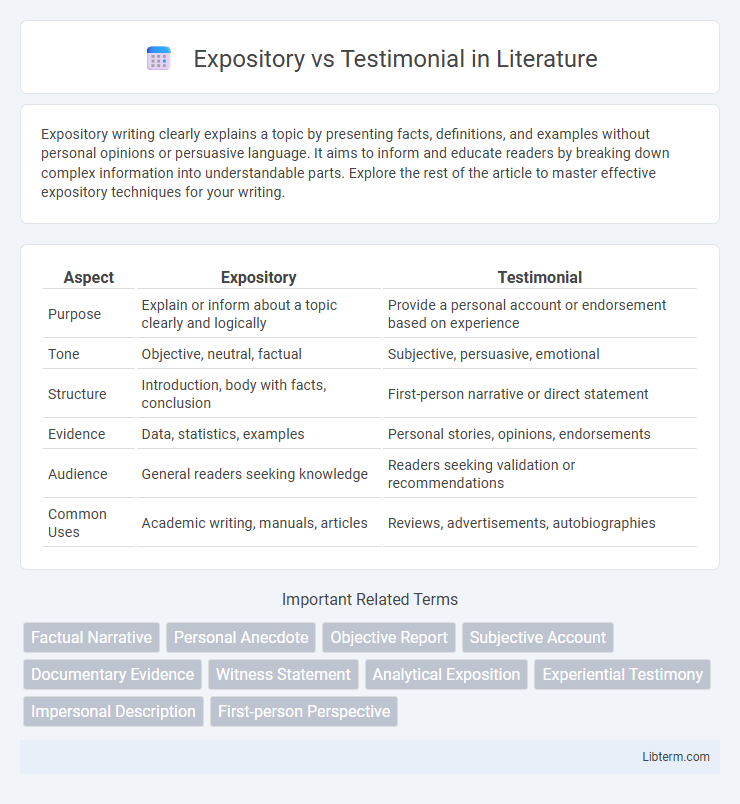Expository writing clearly explains a topic by presenting facts, definitions, and examples without personal opinions or persuasive language. It aims to inform and educate readers by breaking down complex information into understandable parts. Explore the rest of the article to master effective expository techniques for your writing.
Table of Comparison
| Aspect | Expository | Testimonial |
|---|---|---|
| Purpose | Explain or inform about a topic clearly and logically | Provide a personal account or endorsement based on experience |
| Tone | Objective, neutral, factual | Subjective, persuasive, emotional |
| Structure | Introduction, body with facts, conclusion | First-person narrative or direct statement |
| Evidence | Data, statistics, examples | Personal stories, opinions, endorsements |
| Audience | General readers seeking knowledge | Readers seeking validation or recommendations |
| Common Uses | Academic writing, manuals, articles | Reviews, advertisements, autobiographies |
Introduction to Expository and Testimonial Styles
Expository writing presents clear, factual information aimed at explaining or informing the reader with objective evidence and logical structure. Testimonial style relies on personal experiences and firsthand accounts to build credibility and emotional connection with the audience. Both styles serve distinct purposes, with expository focusing on clarity and facts, while testimonials emphasize trust and relatability.
Defining Expository Writing
Expository writing is a form of writing that aims to explain, describe, or inform the reader about a specific topic using clear, concise, and logical information. It relies on facts, evidence, and examples to present an objective analysis, often structured with an introduction, body paragraphs, and a conclusion. Unlike testimonial writing, which is based on personal experiences and opinions, expository writing maintains neutrality and focuses on delivering impartial, well-researched content.
Understanding Testimonial Content
Testimonial content provides authentic, firsthand experiences that build trust and credibility by showcasing real customer stories and opinions. Understanding testimonial content involves analyzing emotional appeal, specific benefits highlighted, and the context in which the product or service is used to enhance relatability and influence potential buyers. This type of content often leverages genuine language and detailed descriptions, distinguishing it from expository content that primarily focuses on explaining facts and features.
Key Differences Between Expository and Testimonial
Expository content provides factual, objective explanations supported by evidence and logical reasoning, focusing on clarity and understanding of a topic. Testimonial content relies on personal experiences, opinions, or endorsements, often aiming to persuade or build trust through subjective accounts. The key differences lie in expository's emphasis on unbiased information and analysis versus testimonial's reliance on individual perspective and emotional appeal.
Purpose and Objectives of Each Approach
Expository writing aims to inform or explain a topic clearly and logically, using facts, statistics, and examples to enhance understanding and provide a comprehensive overview. The primary objective of expository texts is to educate the reader by presenting unbiased information and elucidating complex ideas in a straightforward manner. Testimonial writing, on the other hand, seeks to persuade or build credibility by sharing personal experiences, opinions, and endorsements, focusing on emotional appeal and authenticity to influence the audience's beliefs or decisions.
Structure and Organization
Expository writing follows a logical structure with clear introduction, body, and conclusion, emphasizing factual information and objective analysis. Testimonial writing is organized around personal experiences, often presented in a narrative format that highlights emotions and subjective perspectives. The structured clarity of expository text aims to inform, while testimonials prioritize persuasive storytelling through firsthand accounts.
Language and Tone Comparison
Expository content employs formal, objective language aimed at delivering clear, factual information, often using neutral and precise terminology to explain concepts. Testimonial language is subjective and emotive, incorporating personal pronouns and compelling narratives to build trust and credibility through individual experiences. The tone of expository writing remains impartial and instructional, whereas testimonials adopt a conversational, persuasive tone that resonates on a personal level.
Advantages and Disadvantages
Expository writing offers clear, structured information that enhances reader understanding through facts and logical explanations, making it ideal for educational content, but it may lack emotional engagement. Testimonial writing provides personal experiences that build trust and credibility, appealing emotionally to audiences, yet it can suffer from bias and limited generalizability. Choosing between expository and testimonial depends on the goal of clarity versus persuasion in communication strategies.
When to Use Expository vs Testimonial
Expository content is ideal when the goal is to inform or explain complex topics clearly, making it suitable for educational materials, how-to guides, and detailed product descriptions. Testimonial content works best to build trust and credibility by showcasing real customer experiences and social proof, especially effective in sales pages, service promotions, and brand endorsements. Choosing between expository and testimonial depends on whether the priority is conveying factual information or influencing decisions through authentic personal stories.
Conclusion: Choosing the Right Style
Expository writing provides clear, factual explanations that enhance understanding through logical structure, making it ideal for educational and instructional content. Testimonial writing relies on personal experiences and emotional appeal, fostering trust and authenticity, which suits marketing and persuasive contexts. Selecting the right style depends on the goal: use expository for clarity and information, and testimonial to build credibility and emotional connection.
Expository Infographic

 libterm.com
libterm.com